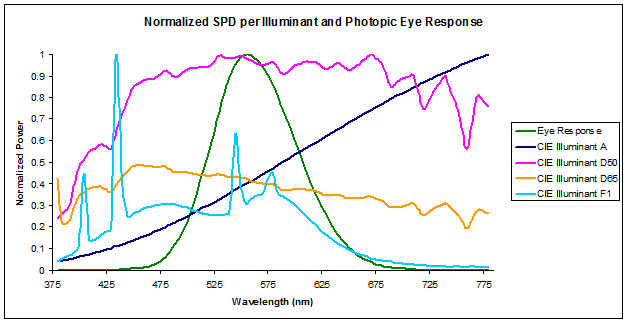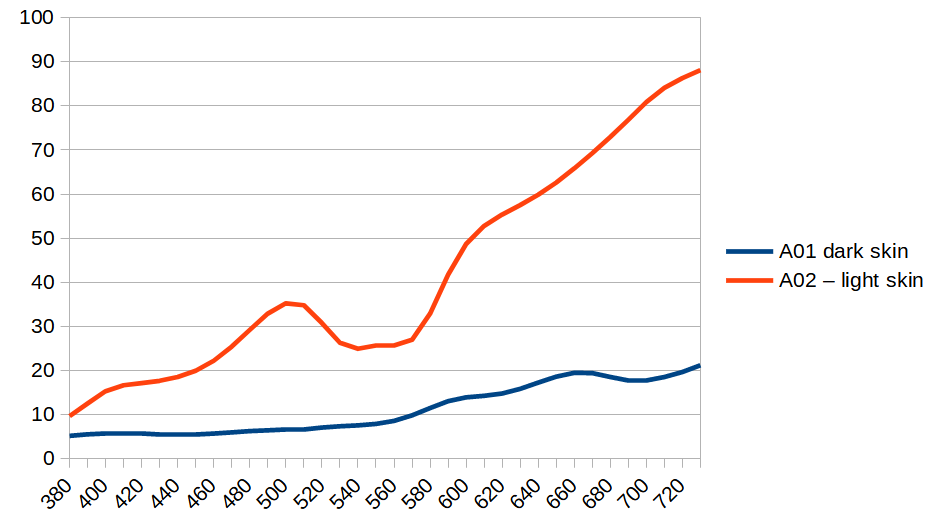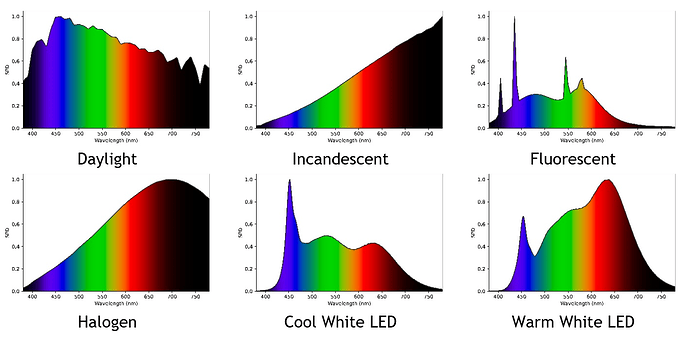Some of you are probably cognizant of my ‘white balance rant’, that is, thinking about color temperature after capture is unproductive. I’ve been thinking further about that, and I’m cogitating a refinement of that to be:
The best light to capture colors is full-spectrum daylight; any other is deficient.
There, now that I’ve lost most, let me continue for the few. First, when you stare into a scene, you’re seeing colors your brain asserts for how each and every visible point in that scene is illuminated. So, whatever energy is produced by the light source is wavelength-selectively reflected off a point, and it’s that amalgam of wavelengths reaching your eye that give the brain information to say, ‘chartreuse’, or whatever color. So, it would follow that, in order for you to get the best information for color assertion, you’d want as-full-as-possible a spectrum of light energy to paint the scene.
Light sources produce different energy levels across the spectrum. Here’s a particularly telling chart of spectral power distributions of different light categories, compared to the human ability to sense them:
Source: Wikimedia Commons, License: https://creativecommons.org/licenses/by-sa/3.0/deed.en
For reference, here are the representative sources for each graphed illuminant:
- A: Tungsten
- D50: ‘Horizon’ daylight
- D65: Midday daylight
- F1: One of thirteen fluorescent sources
Note that, while the Eye Response does cover the well-understood visible spectrum of 380-730nm, its sensitivity attenuates significantly at the tails. But, even more significant, only the D50 and D65 illuminants cover the entire range with consistent energy. And, don’t get me going about F1… well, okay:
LED lights present the same sort of spectral deficiency as fluorescents. An LED is a very narrow-band source, engineered to put its maximum energy at a single wavelength. LED lights available for photography illumination are actually arrays of LEDs, proportioned across three peaks corresponding to what we understand to be ‘red’, ‘green’, and ‘blue’. They get away with that by relying on the eye-brain of most observers to compensate with the miracle of metamerism.
Recognizing this deficiency, the Arri company has developed an LED lighting product called ‘Orbiter’, which arrays LEDs of six different frequencies to better-cover the visible spectrum. Here’s a link to their ‘light-engine’ description at their website:
https://www.arri.com/en/lighting/led-spotlights/orbiter/light-engine
If you don’t want to go there, here’s the essential description:
“Incorporating red, green, blue, amber, cyan, and lime LEDs, the ARRI Spectra six-color light engine provides a wider color gamut, more accurate colors, and most importantly, higher color rendition across the entire CCT range.”
Note: I’m not trying to sell Arri Orbiters, I’m using their product description to bound the problem. Indeed, I’d argue that it’s still ‘deficient’, in that there are still gaps in the power spectrum. It’s that six spectral peaks cover the energy range better than three, so less of a metameric exercise.
American Cinematographer has a good article about the problem, related to skin tones (where I got the notion to read up on their ‘better’ light source, Orbiter):
https://theasc.com/articles/color-fidelity-in-led-volumes
The essence of the problem they’re illustrating is this:
Data source: cc24_ref-new.cie, dcamprof data-examples directory
These are the spectral power distributions for the ColorChecker skin tone patches, A01 and A02. Here’s the corresponding 0-255 RGB values (sRGB, to be precise):
A01 (Dark Skin): 126,80,55
A02 (Light Skin): 215,146,111
Data source: XYZ->RGB conversion, from cc24_ref-new.cie
We tend to think of colors in the RGB triples the camera encodes, but they’re oh-so-much richer in their original spectral environs.
So, my point is, if you want good white balance, you need as much spectral energy across the scene as you can get. Then, you have the best information for subsequent white balance adjustment, and color manipulation.


